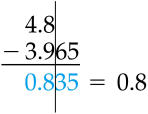What are significant digits?
Significant digits are, well, basically any number really. The number of significant digits that a certain value has is almost always equal to how many numbers there are in the value.
For example, 439 has 3 significant digits - 4, 3, and 9.
98963.4 has 6 significant digits.
11 has 2 significant digits, and so on and so forth.
Okay, are we done here?
 |
| Well done, smarty. |
Not so fast. First of all, realize that significant digits include only the certain digits in a value, and only the first uncertain digit.
Huh?
Let's take a value like 3.27 for example. We know that the 3 and the 2 are concrete digits that we are absolutely sure of. The 7, on the other hand, is a bit iffy. It could easily have been a product of rounding up (3.269) or rounding down (3.274). The significant numbers would include all of the certain digits, and just the first uncertain digit. |
| Only after the 7 do the digits qualify as "significant digits". |
Secondly, notice how the above values only contain non-zero numbers. The situation gets more complicated when zeros are thrown into the mix.
- Leading zeros do not qualify as significant digits: so for a number like 0.0045, there are only 2 sig. figs.
- Zeros that come after a significant digit after a decimal point qualify as significant digits: 0.500 has 3 sig. figs.
- Zeros that come after a significant digit, but before a decimal point do not qualify as significant digits: 8000 only has 1 sig. fig.
Rounding
Give me four different numbers.
Okay...
um...
18.36...
18.32...
18.357...
annnnnd...18.35.
Couldn't have picked them better myself. Okay! Now we'll explore the four different rules of rounding, using these numbers!
What do you think we should round to this time, mmm?
To the tenths place would be nice.
To the tenth it is, then.
To round, first look at the number that's one to the right of the place you're rounding to. In this case, we look at the digit in the hundredth position.
- Let's take the first number, 18.36. In this case, the hundredth position is occupied by 6. 6 is bigger than 5. If the number in the position that's one to the right of the place you're rounding to is bigger than 5, you round up. 18.36 ---> 18.4
- Let's take the second number, 18.32. In this case, the hundredth position is occupied by 2. 2 is smaller than 5. If the number in the position that's one to the right of the place you're rounding to is smaller than 5, you keep the number the same. 18.32 ---> 18.3
- Let's take the third number, 18.357. In this case, the hundredth position is occupied by 5. In an event like this, look to see if there are any more digits to the right of 5. If there are, you would round up. 18.357 ---> 18.4
- Let's take the first number, 18.35. Now there are no numbers after the 5. In an event like this, you would round to make the last digit an even digit. 18.35 ---> 18.4
Didn't I do this in primary school?
Yes. Shut up.
Adding and subtracting is so simple it's ridiculous. Let's take a look at some examples and you can off on your merry way.
72.456 mL
+ 87.222 mL
^ Here we have a simple addition problem. Do what you would normally do to solve for the answer.
 |
| Leave answers with the fewest decimal places possible. |
72.456 mL
+ 87.222 mL
159.678 mL
Now, round using the previously shown method, leaving only one decimal place.
159.678 ---> 159.7 (because 7 > 5)
Multiplying and Dividing
Same goes for multiplying and dividing too. First, do the problem as you normally would, then round the answer to the fewest number of significant digits.
8.82 km x 4.1 km = 36.162 km ²
36.162 rounded to 2 significant figures ---> 36 km ²
Homework:
The two significant figures worksheets :)
Extras:
^ Originally had a neat music video for you, but right after publishing the post, it was discovered that the video wouldn't play. Boo.
So here's a tutorial on sig. figs instead. Skip to around 1:50-ish for the actual explanation; everything before that is just the guy drifting in his own little world.
Significant Digits
^ Quite a useful website. Has questions that you can do, with instant answers.
No comments:
Post a Comment